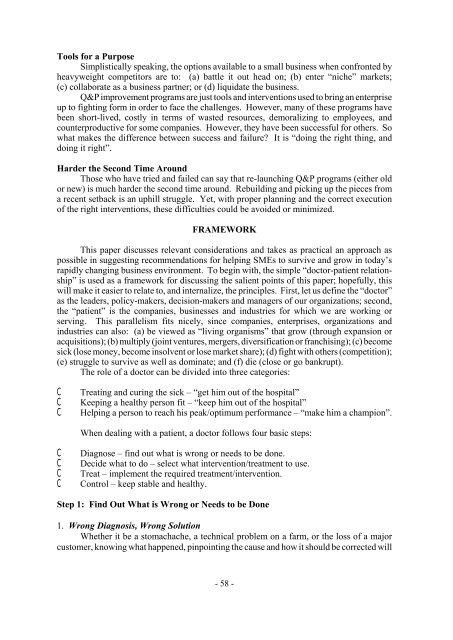Development of Agribusiness Enterprises - Asian Productivity ...
Development of Agribusiness Enterprises - Asian Productivity ...
Development of Agribusiness Enterprises - Asian Productivity ...
You also want an ePaper? Increase the reach of your titles
YUMPU automatically turns print PDFs into web optimized ePapers that Google loves.
Tools for a Purpose<br />
Simplistically speaking, the options available to a small business when confronted by<br />
heavyweight competitors are to: (a) battle it out head on; (b) enter “niche” markets;<br />
(c) collaborate as a business partner; or (d) liquidate the business.<br />
Q&P improvement programs are just tools and interventions used to bring an enterprise<br />
up to fighting form in order to face the challenges. However, many <strong>of</strong> these programs have<br />
been short-lived, costly in terms <strong>of</strong> wasted resources, demoralizing to employees, and<br />
counterproductive for some companies. However, they have been successful for others. So<br />
what makes the difference between success and failure? It is “doing the right thing, and<br />
doing it right”.<br />
Harder the Second Time Around<br />
Those who have tried and failed can say that re-launching Q&P programs (either old<br />
or new) is much harder the second time around. Rebuilding and picking up the pieces from<br />
a recent setback is an uphill struggle. Yet, with proper planning and the correct execution<br />
<strong>of</strong> the right interventions, these difficulties could be avoided or minimized.<br />
FRAMEWORK<br />
This paper discusses relevant considerations and takes as practical an approach as<br />
possible in suggesting recommendations for helping SMEs to survive and grow in today’s<br />
rapidly changing business environment. To begin with, the simple “doctor-patient relationship”<br />
is used as a framework for discussing the salient points <strong>of</strong> this paper; hopefully, this<br />
will make it easier to relate to, and internalize, the principles. First, let us define the “doctor”<br />
as the leaders, policy-makers, decision-makers and managers <strong>of</strong> our organizations; second,<br />
the “patient” is the companies, businesses and industries for which we are working or<br />
serving. This parallelism fits nicely, since companies, enterprises, organizations and<br />
industries can also: (a) be viewed as “living organisms” that grow (through expansion or<br />
acquisitions); (b) multiply (joint ventures, mergers, diversification or franchising); (c) become<br />
sick (lose money, become insolvent or lose market share); (d) fight with others (competition);<br />
(e) struggle to survive as well as dominate; and (f) die (close or go bankrupt).<br />
The role <strong>of</strong> a doctor can be divided into three categories:<br />
C Treating and curing the sick – “get him out <strong>of</strong> the hospital”<br />
C Keeping a healthy person fit – “keep him out <strong>of</strong> the hospital”<br />
C Helping a person to reach his peak/optimum performance – “make him a champion”.<br />
When dealing with a patient, a doctor follows four basic steps:<br />
C Diagnose – find out what is wrong or needs to be done.<br />
C Decide what to do – select what intervention/treatment to use.<br />
C Treat – implement the required treatment/intervention.<br />
C Control – keep stable and healthy.<br />
Step 1: Find Out What is Wrong or Needs to be Done<br />
1. Wrong Diagnosis, Wrong Solution<br />
Whether it be a stomachache, a technical problem on a farm, or the loss <strong>of</strong> a major<br />
customer, knowing what happened, pinpointing the cause and how it should be corrected will<br />
- 58 -
















